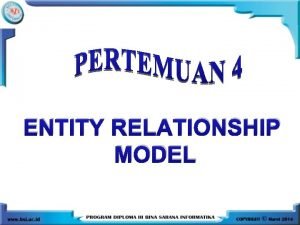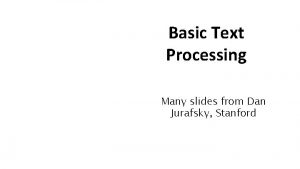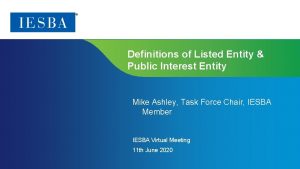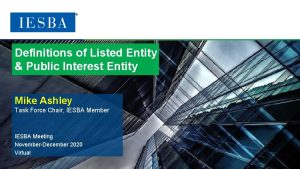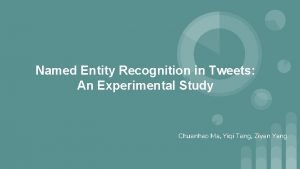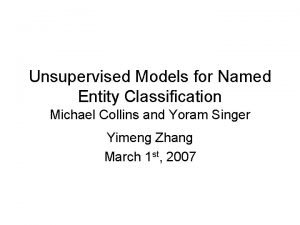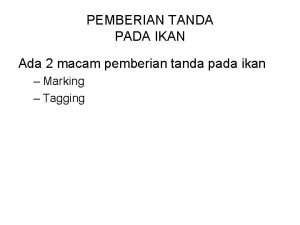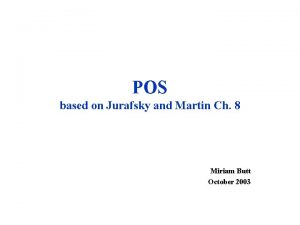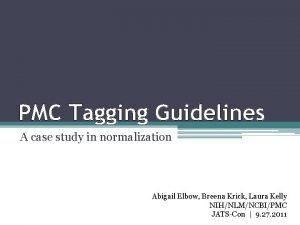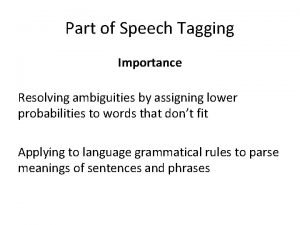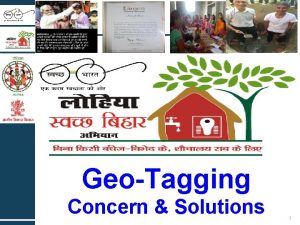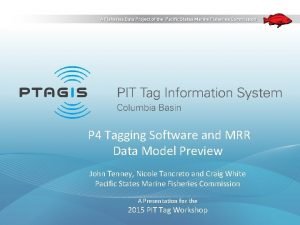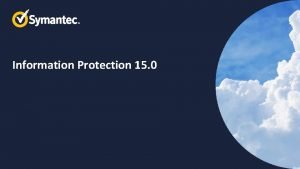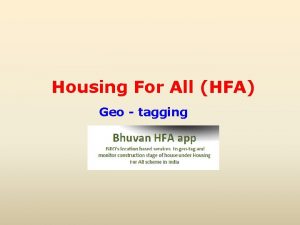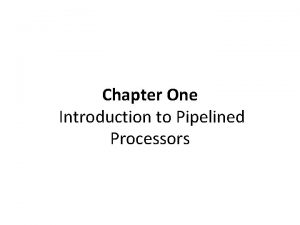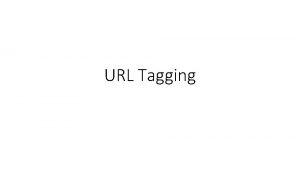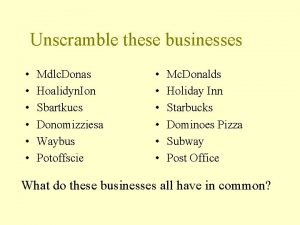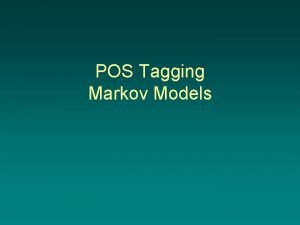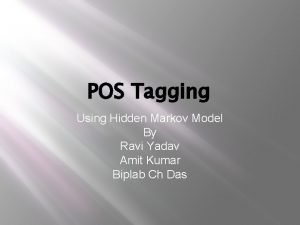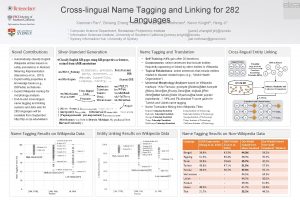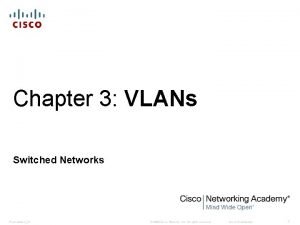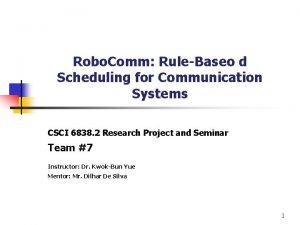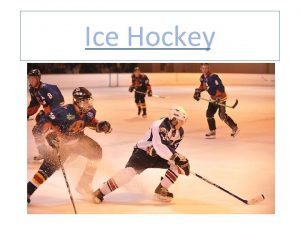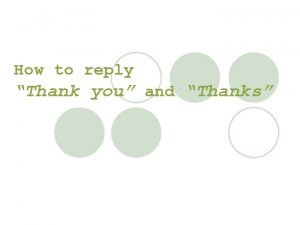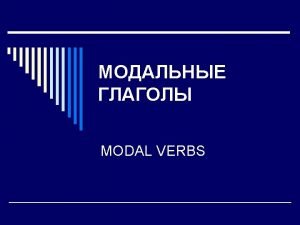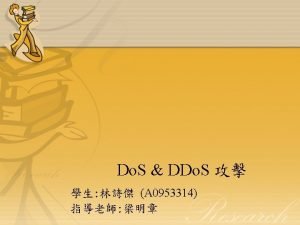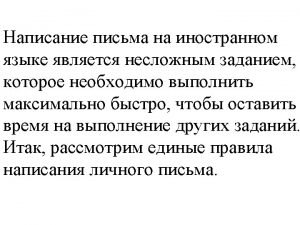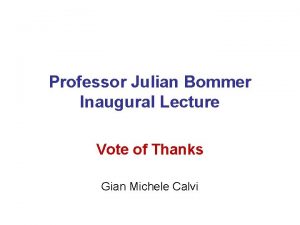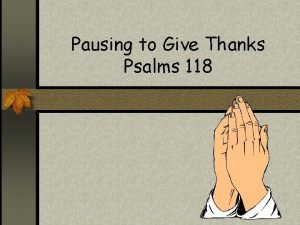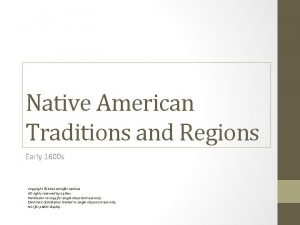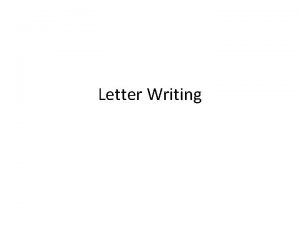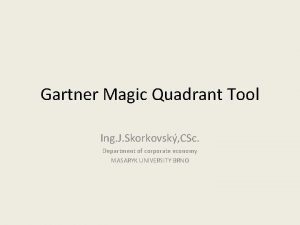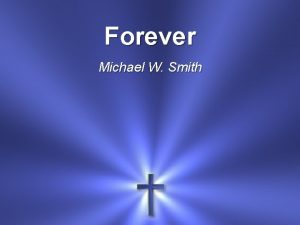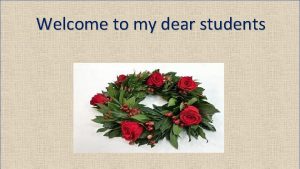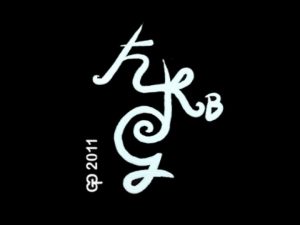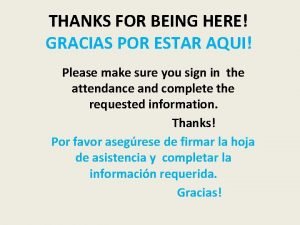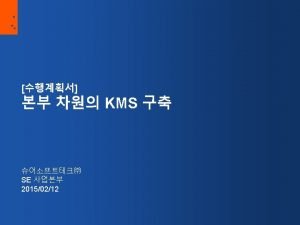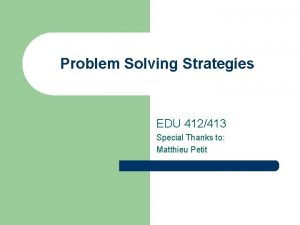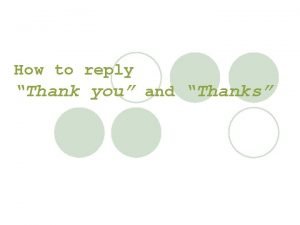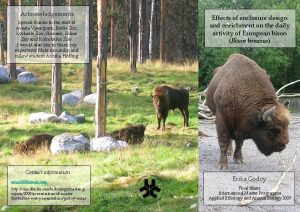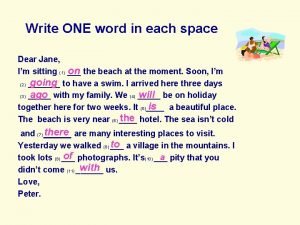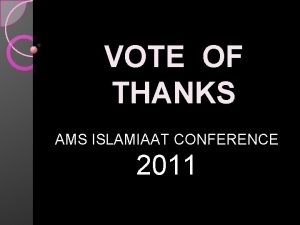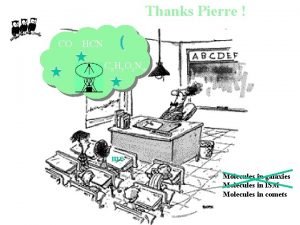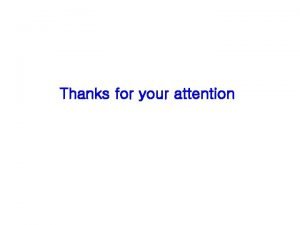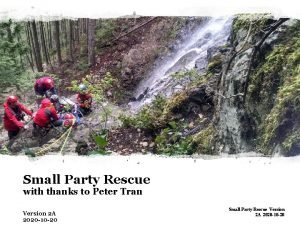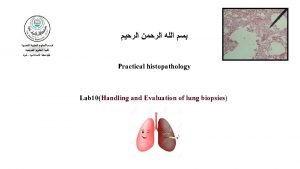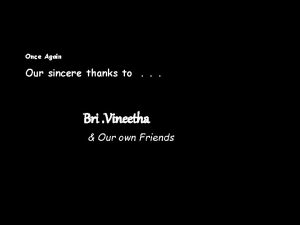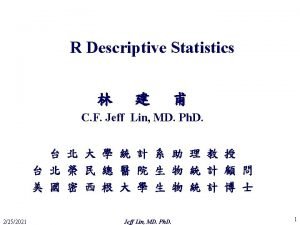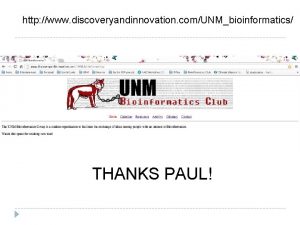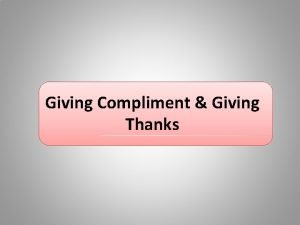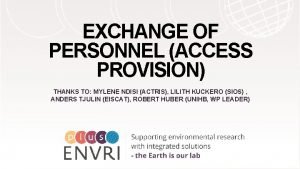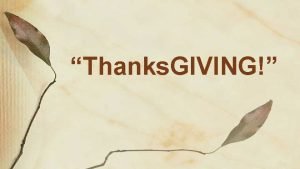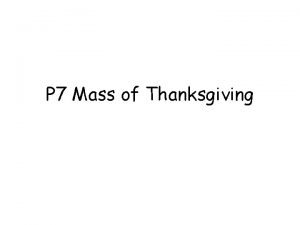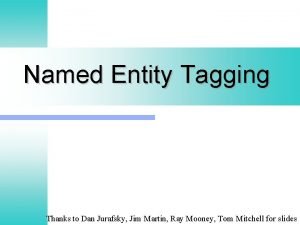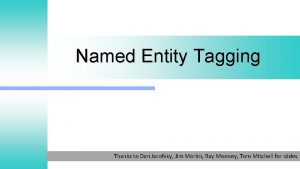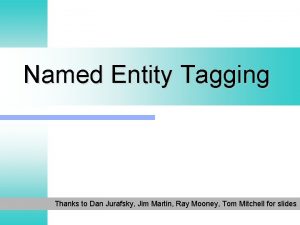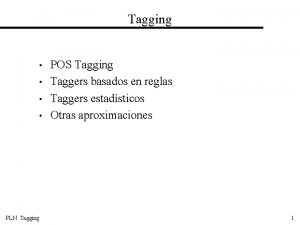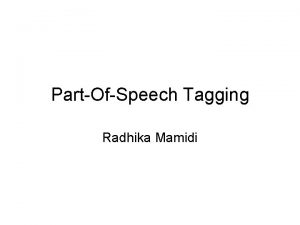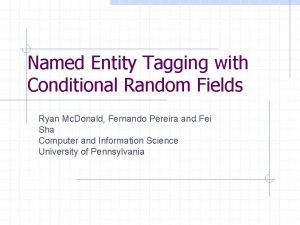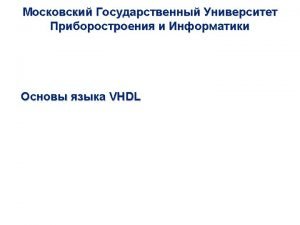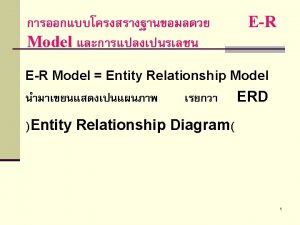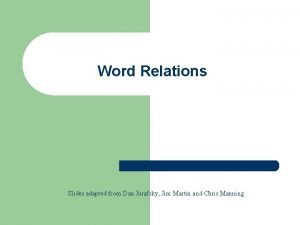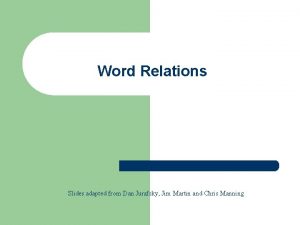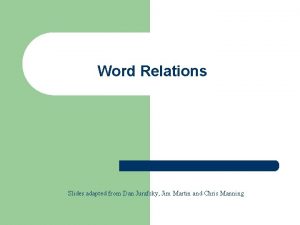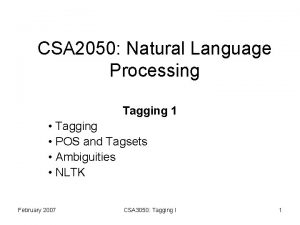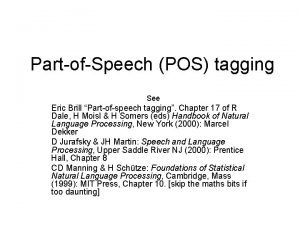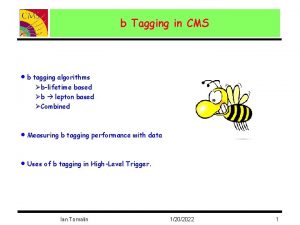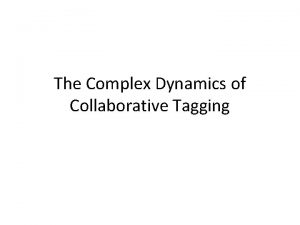Named Entity Tagging Thanks to Dan Jurafsky Jim

























![Logistic function Inverse, aka Sigmoid, maps p to range [0 -1] Logistic function Inverse, aka Sigmoid, maps p to range [0 -1]](https://slidetodoc.com/presentation_image/6fdd9c8afb22625bc42d418fc833d5d9/image-26.jpg)






















































- Slides: 80

Named Entity Tagging Thanks to Dan Jurafsky, Jim Martin, Ray Mooney, Tom Mitchell for slides

Outline Named Entities and the basic idea l IOB Tagging l A new classifier: Logistic Regression l § Linear regression § Logistic regression § Multinomial logistic regression = Max. Ent Why classifiers aren’t as good as sequence models l A new sequence model: l § MEMM = Maximum Entropy Markov Model

Named Entity Tagging CHICAGO (AP) — Citing high fuel prices, United Airlines said Friday it has increased fares by $6 per round trip on flights to some cities also served by lower-cost carriers. American Airlines, a unit AMR, immediately matched the move, spokesman Tim Wagner said. United, a unit of UAL, said the increase took effect Thursday night and applies to most routes where it competes against discount carriers, such as Chicago to Dallas and Atlanta and Denver to San Francisco, Los Angeles and New York. Slide from Jim Martin

Named Entity Tagging CHICAGO (AP) — Citing high fuel prices, United Airlines said Friday it has increased fares by $6 per round trip on flights to some cities also served by lower-cost carriers. American Airlines, a unit AMR, immediately matched the move, spokesman Tim Wagner said. United, a unit of UAL, said the increase took effect Thursday night and applies to most routes where it competes against discount carriers, such as Chicago to Dallas and Atlanta and Denver to San Francisco, Los Angeles and New York. Slide from Jim Martin

Named Entity Recognition Find the named entities and classify them by type l Typical approach l § § Acquire training data Encode using IOB labeling Train a sequential supervised classifier Augment with pre- and post-processing using available list resources (census data, gazetteers, etc. ) Slide from Jim Martin

Temporal and Numerical Expressions l Temporals § Find all the temporal expressions § Normalize them based on some reference point l Numerical Expressions § Find all the expressions § Classify by type § Normalize Slide from Jim Martin

NE Types Slide from Jim Martin

NE Types: Examples Slide from Jim Martin

Ambiguity Slide from Jim Martin

Biomedical Entities l l l l Disease Symptom Drug Body Part Treatment Enzime Protein Difficulty: discontiguous or overlapping mentions § Abdomen is soft, nontender, nondistended, negative bruits

NER Approaches l As with partial parsing and chunking there are two basic approaches (and hybrids) § Rule-based (regular expressions) • Lists of names • Patterns to match things that look like names • Patterns to match the environments that classes of names tend to occur in. § ML-based approaches • Get annotated training data • Extract features • Train systems to replicate the annotation Slide from Jim Martin

ML Approach Slide from Jim Martin

Encoding for Sequence Labeling We can use IOB encoding: …United Airlines said Friday it has increased l B_ORG I_ORG O O O the move , spokesman Tim Wagner said. O O O B_PER I_PER O l How many tags? § For N classes we have 2*N+1 tags • An I and B for each class and one O for no-class Each token in a text gets a tag l Can use simpler IO tagging if what? l

NER Features Slide from Jim Martin

Discriminative vs Generative l Generative Model: § Estimate full joint distribution P(y, x) § Use Bayes rule to obtain P(y | x) or use argmax for classification: l Discriminative model: § Estimate P(y | x) in order to predict y from x

How to do NE tagging? l Classifiers § Naïve Bayes § Logistic Regression l Sequence Models § § HMMs MEMMs CRFs Convolutional Neural Network l Sequence models work better

Linear Regression l Example from Freakonomics (Levitt and Dubner 2005) § Fantastic/cute/charming versus granite/maple l # vague adjective Price increase 4 0 3 $1000 2 $1500 2 $6000 1 $14000 0 $18000 Can we predict price from # of adjs?

Linear Regression

Muliple Linear Regression l Predicting values: l In general: § Let’s pretend an extra “intercept” feature f 0 with value 1 l Multiple Linear Regression

Learning in Linear Regression l Consider one instance xj l We would like to choose weights to minimize the difference between predicted and observed value for xj: l This is an optimization problem that turns out to have a closed-form solution

l Put the weight from the training set into matrix X of observations f(i) l Put the observed values in a vector l Formula that minimizes the cost: W = (XTX)− 1 XTy y

Logistic Regression

Logistic Regression l But in language problems we are doing classification § Predicting one of a small set of discrete values l Could we just use linear regression for this?

Logistic regression l Not possible: the result doesn’t fall between 0 and 1 l Instead of predicting prob, predict ratio of probs: § but still not good: does not lie between 0 and 1 l So how about if we predict the log:

Logistic regression l Solving this for p(y=true)
![Logistic function Inverse aka Sigmoid maps p to range 0 1 Logistic function Inverse, aka Sigmoid, maps p to range [0 -1]](https://slidetodoc.com/presentation_image/6fdd9c8afb22625bc42d418fc833d5d9/image-26.jpg)
Logistic function Inverse, aka Sigmoid, maps p to range [0 -1]

Logistic Regression l How do we do classification? Or: Or, in explicit sum notation:

Multinomial logistic regression l Multiple classes: l One change: indicator functions instead of real values f(c, x)

Estimating the weights l Generalized Iterative Scaling (GIS) § (Darroch and Ratcliff, 1972) l Improved Iterative Scaling (IIS) § (Della Pietra et al. , 1995)

GIS: setup Requirements for running GIS: l Obey form of model and constraints: l An additional constraint: l Add a new feature fk+1:

GIS algorithm Compute dj, j=1, …, k+1 l Initialize (any values, e. g. , 0) l Repeat until converge l § for each j • compute where • update

Features

Summary so far Naïve Bayes Classifier l Logistic Regression Classifier l § Also called Maximum Entropy classifier

How do we apply classification to sequences?

Sequence Labeling as Classification l Classify each token independently but use as input features, information about the surrounding tokens (sliding window). John saw the saw and decided to take it to the table. classifier NNP Slide from Ray Mooney

Sequence Labeling as Classification l Classify each token independently but use as input features, information about the surrounding tokens (sliding window). John saw the saw and decided to take it to the table. classifier VBD Slide from Ray Mooney

Sequence Labeling as Classification l Classify each token independently but use as input features, information about the surrounding tokens (sliding window). John saw the saw and decided to take it to the table. classifier DT Slide from Ray Mooney

Sequence Labeling as Classification l Classify each token independently but use as input features, information about the surrounding tokens (sliding window). John saw the saw and decided to take it to the table. classifier NN Slide from Ray Mooney

Sequence Labeling as Classification l Classify each token independently but use as input features, information about the surrounding tokens (sliding window). John saw the saw and decided to take it to the table. classifier CC Slide from Ray Mooney

Sequence Labeling as Classification l Classify each token independently but use as input features, information about the surrounding tokens (sliding window). John saw the saw and decided to take it to the table. classifier VBD Slide from Ray Mooney

Sequence Labeling as Classification l Classify each token independently but use as input features, information about the surrounding tokens (sliding window). John saw the saw and decided to take it to the table. classifier TO Slide from Ray Mooney

Sequence Labeling as Classification l Classify each token independently but use as input features, information about the surrounding tokens (sliding window). John saw the saw and decided to take it to the table. classifier VB Slide from Ray Mooney

Sequence Labeling as Classification l Classify each token independently but use as input features, information about the surrounding tokens (sliding window). John saw the saw and decided to take it to the table. classifier PRP Slide from Ray Mooney

Sequence Labeling as Classification l Classify each token independently but use as input features, information about the surrounding tokens (sliding window). John saw the saw and decided to take it to the table. classifier IN Slide from Ray Mooney

Sequence Labeling as Classification l Classify each token independently but use as input features, information about the surrounding tokens (sliding window). John saw the saw and decided to take it to the table. classifier DT Slide from Ray Mooney

Sequence Labeling as Classification l Classify each token independently but use as input features, information about the surrounding tokens (sliding window). John saw the saw and decided to take it to the table. classifier NN Slide from Ray Mooney

Using Outputs as Inputs l Better input features are usually the categories of the surrounding tokens, but these are not available yet l Can use category of either the preceding or succeeding tokens by going forward or back and using previous output Slide from Ray Mooney

Forward Classification John saw the saw and decided to take it to the table. classifier NNP Slide from Ray Mooney

Forward Classification NNP John saw the saw and decided to take it to the table. classifier VBD Slide from Ray Mooney

Forward Classification NNP VBD John saw the saw and decided to take it to the table. classifier DT Slide from Ray Mooney

Forward Classification NNP VBD DT John saw the saw and decided to take it to the table. classifier NN Slide from Ray Mooney

Forward Classification NNP VBD DT NN John saw the saw and decided to take it to the table. classifier CC Slide from Ray Mooney

Forward Classification NNP VBD DT NN CC John saw the saw and decided to take it to the table. classifier VBD Slide from Ray Mooney

Forward Classification NNP VBD DT NN CC VBD John saw the saw and decided to take it to the table. classifier TO Slide from Ray Mooney

Forward Classification NNP VBD DT NN CC VBD TO John saw the saw and decided to take it to the table. classifier VB Slide from Ray Mooney

Backward Classification l Disambiguating “to” in this case would be even easier backward. DT NN John saw the saw and decided to take it to the table. classifier IN Slide from Ray Mooney

Backward Classification l Disambiguating “to” in this case would be even easier backward. IN DT NN John saw the saw and decided to take it to the table. classifier PRP Slide from Ray Mooney

Backward Classification l Disambiguating “to” in this case would be even easier backward. PRP IN DT NN John saw the saw and decided to take it to the table. classifier VB Slide from Ray Mooney

Backward Classification l Disambiguating “to” in this case would be even easier backward. VB PRP IN DT NN John saw the saw and decided to take it to the table. classifier TO Slide from Ray Mooney

Backward Classification l Disambiguating “to” in this case would be even easier backward. TO VB PRP IN DT NN John saw the saw and decided to take it to the table. classifier VBD Slide from Ray Mooney

Backward Classification l Disambiguating “to” in this case would be even easier backward. VBD TO VB PRP IN DT NN John saw the saw and decided to take it to the table. classifier CC Slide from Ray Mooney

Backward Classification l Disambiguating “to” in this case would be even easier backward. CC VBD TO VB PRP IN DT NN John saw the saw and decided to take it to the table. classifier VBD Slide from Ray Mooney

Backward Classification l Disambiguating “to” in this case would be even easier backward. VBD CC VBD TO VB PRP IN DT NN John saw the saw and decided to take it to the table. classifier DT Slide from Ray Mooney

Backward Classification l Disambiguating “to” in this case would be even easier backward. DT VBD CC VBD TO VB PRP IN DT NN John saw the saw and decided to take it to the table. classifier VBD Slide from Ray Mooney

Backward Classification l Disambiguating “to” in this case would be even easier backward. VBD DT VBD CC VBD TO VB PRP IN DT NN John saw the saw and decided to take it to the table. classifier NNP Slide from Ray Mooney

NER as Sequence Labeling

Why classifiers are not as good as sequence models

Problems with using Classifiers for Sequence Labeling l It is not easy to integrate information from hidden labels on both sides l We make a hard decision on each token § We should rather choose a global optimum § The best labeling for the whole sequence § Keeping each local decision as just a probability, not a hard decision

Probabilistic Sequence Models l Probabilistic sequence models allow integrating uncertainty over multiple, interdependent classifications and collectively determine the most likely global assignment l Common approaches § Hidden Markov Model (HMM) § Conditional Random Field (CRF) § Maximum Entropy Markov Model (MEMM) is a simplified version of CRF § Convolutional Neural Networks (CNN)

HMMs vs. MEMMs Slide from Jim Martin

HMMs vs. MEMMs Slide from Jim Martin

HMMs vs. MEMMs Slide from Jim Martin

HMM vs MEMM

Viterbi in MEMMs l We condition on the observation AND the previous state: l HMM decoding: l Which is the HMM version of: l MEMM decoding:

Decoding in MEMMs

Evaluation Metrics

Precision: how many of the names we returned are really names? l Recall: how many of the names in the database did we find? l

F-measure l F-measure is a way to combine these: l More generally:

F-measure l Harmonic mean is the reciprocal of arthithmetic mean of reciprocals: l Hence F-measure is:

Outline Named Entities and the basic idea l IOB Tagging l A new classifier: Logistic Regression l § Linear regression § Logistic regression § Multinomial logistic regression = Max. Ent Why classifiers are not as good as sequence models l A new sequence model: l § MEMM = Maximum Entropy Markov Model
 Total participation constraint adalah
Total participation constraint adalah Simbol weak entity
Simbol weak entity Dan jurafsky nlp
Dan jurafsky nlp Dan jurafsky nlp slides
Dan jurafsky nlp slides Public interest entity vs listed entity
Public interest entity vs listed entity Public interest entity
Public interest entity Named entity recognition in tweets: an experimental study
Named entity recognition in tweets: an experimental study Unsupervised models for named entity classification
Unsupervised models for named entity classification Marking dan tagging biasanya dilakukan oleh para
Marking dan tagging biasanya dilakukan oleh para Jurafsky & martin
Jurafsky & martin Stylechecker
Stylechecker Pos taging
Pos taging Geo-tagging in panchayat
Geo-tagging in panchayat Definisi program
Definisi program Mrrdata.com
Mrrdata.com Information centric security
Information centric security Bhuvan hfa beneficiary details
Bhuvan hfa beneficiary details Internal forwarding and register tagging
Internal forwarding and register tagging Raven tools url builder
Raven tools url builder Donas franchise
Donas franchise Tagging
Tagging Unsupervised pos tagging
Unsupervised pos tagging Cross-lingual name tagging and linking for 282 languages
Cross-lingual name tagging and linking for 282 languages Untagged vs tagged vlan
Untagged vs tagged vlan Alleluia alleluia give thanks to the risen lord lyrics
Alleluia alleluia give thanks to the risen lord lyrics Thanks for the victory
Thanks for the victory Thanks for listening slide
Thanks for listening slide Thanks for listen
Thanks for listen Gustation and olfaction
Gustation and olfaction Thanks for listening
Thanks for listening How to reply thanks
How to reply thanks Thanks any question
Thanks any question Give thanks to the lord our god and king
Give thanks to the lord our god and king Blie danube
Blie danube Thanks to god for my redeemer
Thanks to god for my redeemer Oh give thanks to the lord for he is good
Oh give thanks to the lord for he is good спасобо
спасобо Ten thousand thanks to jesus
Ten thousand thanks to jesus The end thanks for listening
The end thanks for listening Thanks for teamwork
Thanks for teamwork Kwakiutl prayer of thanks
Kwakiutl prayer of thanks Thank you for your last letter
Thank you for your last letter Vote of thanks speech for teachers
Vote of thanks speech for teachers Is the gulf stream warm or cold
Is the gulf stream warm or cold From woodlands to plains
From woodlands to plains Sorry i haven't written sooner
Sorry i haven't written sooner Thanks for attention
Thanks for attention His love endures forever michael w smith
His love endures forever michael w smith First of all thanks to allah
First of all thanks to allah Farabi and flora
Farabi and flora Welcome thanks for joining us
Welcome thanks for joining us Thanks for bringing us together
Thanks for bringing us together Thanks for being here
Thanks for being here Thank you to all the sponsors
Thank you to all the sponsors Thank you for your kind notice.
Thank you for your kind notice. Thanks for solving the problem
Thanks for solving the problem Oh give thanks to the lord for he is good
Oh give thanks to the lord for he is good In everything give thanks to the lord
In everything give thanks to the lord How to reply thanks
How to reply thanks Conclusion about presentation
Conclusion about presentation Thanks gane
Thanks gane Acknowledgement special thanks to
Acknowledgement special thanks to Complete the email. write one word for each space
Complete the email. write one word for each space Vote of thanks
Vote of thanks Cx hy oz
Cx hy oz Thanks for your attention
Thanks for your attention Thanks
Thanks Small party assisted rescue
Small party assisted rescue Thanks for your attention
Thanks for your attention Thanks for listening
Thanks for listening Thanks bri
Thanks bri What is microfiction
What is microfiction Thanks 2021
Thanks 2021 Thanks paul
Thanks paul Expression of compliment
Expression of compliment Thanks for your attention
Thanks for your attention Thanks
Thanks Thanks to provision
Thanks to provision Thanks for the reminder.
Thanks for the reminder. Alleluia alleluia give thanks to the risen lord
Alleluia alleluia give thanks to the risen lord Be joyful always pray continually give thanks
Be joyful always pray continually give thanks

